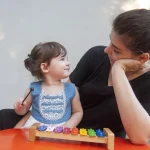Keeping little ones busy can be a full-time job, so it’s always useful to have ideas on-hand for fun activities that you can do together. The best way for children to learn, no matter their abilities, is through play. Play is all about discovery — and having fun. Here are 10 stimulating activities that you can do indoors with your child. Be patient, listen and enjoy spending time and learning together!
1. Place a variety of toys on a tray or flat surface to stimulate your child. Try sensory toys or toys with suction cups that will stick on flat surfaces. You could also use sponges or cups.
2. Make up a game using a ball — you can even make one together using cloth. Decide the best way to play with your hands and feet depending on the mobility of your child.
3. Make a video of the things you have recorded your child doing and play it for them. You can also do this with just an audio recorder to play back their singing or laughing.
4. Take your children to the kitchen to help prepare food. Depending on what you’re doing and how interested your child is, you can let them help you or just give them their own plastic bowl and spoon to mimic your actions.
5. Take advantage of their artistic talents and let them colour or paint. There are brushes and drawing utensils that have big easy-to-grab shapes so that children who have little mobility can easily grab them! Finger painting is also a fun option.
6. Read books together in a comfortable position sitting or standing (depending on your child’s ability). You can also pull out family photo albums and point to familiar faces. Finding the best position, which can be done with a pillow or using an angled tray on a table, will help your child to feel more comfortable and encourage him to keep his head up.
7. Make a tray of water or sand for your child to play with different textures. You can also add toys.
8. Play with dough, either clay or homemade. Use molds and have fun cutting and assembling shapes. Cookie cutters or large cups with large handles may be easier for your child to grasp.
9. Spend some quiet time playing with simple puzzles or making shape, colour, word or number cards. Using a flat, smooth surface such as a table or tray will make the activity easier.
10. Sing, dance and make noise with your child. Your little one can use any cooking pot and homemade instruments to keep rhythm with you.






